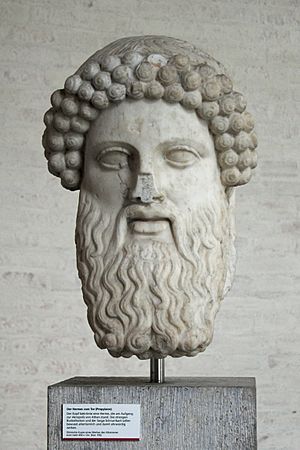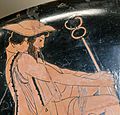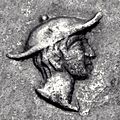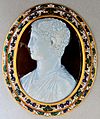Hermes facts for kids
Quick facts for kids Hermes |
|
|---|---|
| God of boundaries, roads and travelers, thieves, athletes, shepherds, commerce, speed, cunning, wit, and sleep. Psychopomp and divine messenger |
|
| Member of the Twelve Olympians | |
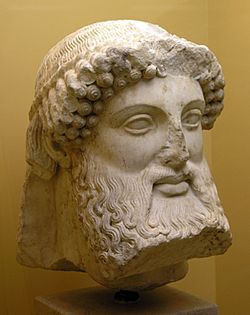
Archaic bearded Hermes from a herm, early 5th century BC.
|
|
| Abode | Mount Olympus |
| Planet | Mercury |
| Symbol | Talaria, caduceus, tortoise, lyre, rooster, Petasos (Winged helmet) |
| Day | Wednesday (hēméra Hermoû) |
| Personal information | |
| Children | Evander, Pan, Hermaphroditus, Abderus, Autolycus, Eudoros, Angelia, Myrtilus, Palaestra |
| Parents | Zeus and Maia Uranus and Hemera (Cicero and Hyginus) |
| Siblings | Aeacus, Angelos, Aphrodite, Apollo, Ares, Artemis, Athena, Dionysus, Eileithyia, Enyo, Eris, Ersa, Hebe, Helen of Troy, Hephaestus, Heracles, Minos, Pandia, Persephone, Perseus, Rhadamanthus, the Charites, the Horae, the Litae, the Muses, the Moirai |
| Equivalents | |
| Roman equivalent | Mercury |
| Norse equivalent | Odin |
| Etruscan equivalent | Turms |
| Egyptian equivalent | Thoth, Anubis |
Hermes is a very important god in Greek mythology. He is known as the messenger of the gods. He is also the god of travellers and shepherds. Hermes is one of the Twelve Olympians, who were the main gods living on Mount Olympus. You can often spot him by his special staff, called a caduceus.
Hermes has many symbols that help identify him. These include a stone pillar called a herma, a rooster, and a tortoise. He also carries a satchel or pouch. He wears special talaria (winged sandals) and a winged helmet or a simple wide-brimmed hat called a petasos. Other symbols are the palm tree, a goat, and the number four.
In Roman mythology, many of Hermes' traits belong to a god named Mercury. The name Mercury comes from a Latin word meaning "merchandise." This is where words like "merchant" and "commerce" come from.
Hermes is the son of Zeus, the king of the gods, and Maia, a beautiful nymph. He was born on Mount Cyllene. The story of his birth is told in an ancient poem called the Homeric Hymn to Hermes. Hermes was very clever from the day he was born. On his first day, he invented the lyre (a musical instrument) using a tortoise shell. One famous myth tells how he once stole his brother Apollo's oxen and offered them as a sacrifice.
Contents
Hermes: Name and Early Worship
The name "Hermes" likely comes from the Greek word for "stone heap." It is thought that Hermes was worshiped in Greece even before the main Greek gods became popular. His worship started in quiet, rural areas. This suggests he was originally a god of nature, farmers, and shepherds.
Hermes' Appearance and Symbols

Hermes' appearance changed over time in Greek art. In older art, he was shown as an older man with a beard, dressed like a traveler, messenger, or shepherd. Later, in more modern Greek art, Hermes was usually shown as a young, athletic man without a beard.
However, some special objects always helped people know it was Hermes.
- The petasos is a wide-brimmed hat. People in the countryside wore it to protect themselves from the sun. Later, this hat was shown with small wings. Sometimes, instead of a hat, wings were shown coming directly from his hair.
- The caduceus is a staff with two snakes wrapped around it. Sometimes it also has wings and a sphere on top. This symbol has been around for a very long time, even before ancient Greece. It was said to have the power to make people sleep or wake up. It also helped make peace between people arguing. It was a clear sign of Hermes' authority.
- Hermes' sandals were called pédila by the Greeks and talaria by the Romans. They were described as beautiful, golden, and magical. They allowed him to travel with the speed of the wind. At first, these sandals did not have wings. But later, artists started showing them with wings. Sometimes, the wings appeared to come right from his ankles.
Hermes was also often shown holding a purse or bag. He wore a special robe or cloak that could make him invisible.
Hermes' Important Roles
Hermes had many important jobs. He was strongly connected to the earth and the underworld (the land of the dead).
- God of Boundaries: He was a god of boundaries, like the line between life and death. His image was often placed on gravestones in ancient Greece.
- Guide of Souls: Hermes was a deity who helped guide the souls of people who had died to the afterlife. This role is called a psychopomp.
- Divine Messenger: He was known as the messenger god. He could carry messages between the gods, the underworld, and the world of humans.
Hermes was also the special god of flocks, herds, and shepherds. In one story, he saved a town from a terrible sickness by carrying a ram (a male sheep) around the city walls. To remember this, people held a yearly festival. During this festival, a lamb was carried around the city by "the most handsome boy" and then sacrificed. This was done to keep the city safe from sickness, dry weather, and hunger. Many statues show Hermes as a shepherd god carrying a lamb on his shoulders. This image might have even influenced early Christianity, where Jesus is sometimes called "the Good Shepherd."
Temples and Sacred Places for Hermes
Not many temples were built just for Hermes during the Classical Greek period. Only three are known, all in a region called Arcadia. One of the oldest places where Hermes was worshiped was Mount Cyllene in Arcadia. Some myths say he was born there. People believed that his first temple was built by a king named Lycaon. From Arcadia, the worship of Hermes spread to Athens and then to all of Greece. Later, during the Roman period, more temples for Hermes (Mercury) were built across the Roman Empire, including some in modern-day Tunisia.
Hermes was also the patron god of gyms and fighting. Because of this, his statues were found in gyms. He was also worshiped at the sanctuary of the Twelve Gods in Olympia, where the Olympic Games were held. His statue was placed on an altar dedicated to both him and Apollo.
People would offer honey, cakes, pigs, goats, and lambs as sacrifices to Hermes. In the city of Tanagra, people believed that Hermes was nursed under a wild strawberry tree. The remains of this tree were kept in a shrine dedicated to Hermes. In the hills of Phene, there were three waterways that were sacred to him. People believed he was bathed there when he was born.
Children of Hermes
- Tyche was a daughter he had with Aphrodite.
- Hermaphrodites was a son he had with Aphrodite.
Related pages
- Family tree of the Greek gods
- Mercury- The Roman mythology version of Hermes.
Images for kids
-
Charon in his boat, receiving Hermes psychopompos who leads a deceased woman.
-
Hermes Fastening his Sandal, early Imperial Roman marble copy of a Lysippan bronze (Louvre Museum)
-
Hermes wearing a petasos. Coinage of Kapsa, Macedon, c. 400 BC.
-
Sardonyx cameo of a Ptolemaic prince as Hermes, Cabinet des médailles, Paris
See also
 In Spanish: Hermes para niños
In Spanish: Hermes para niños



